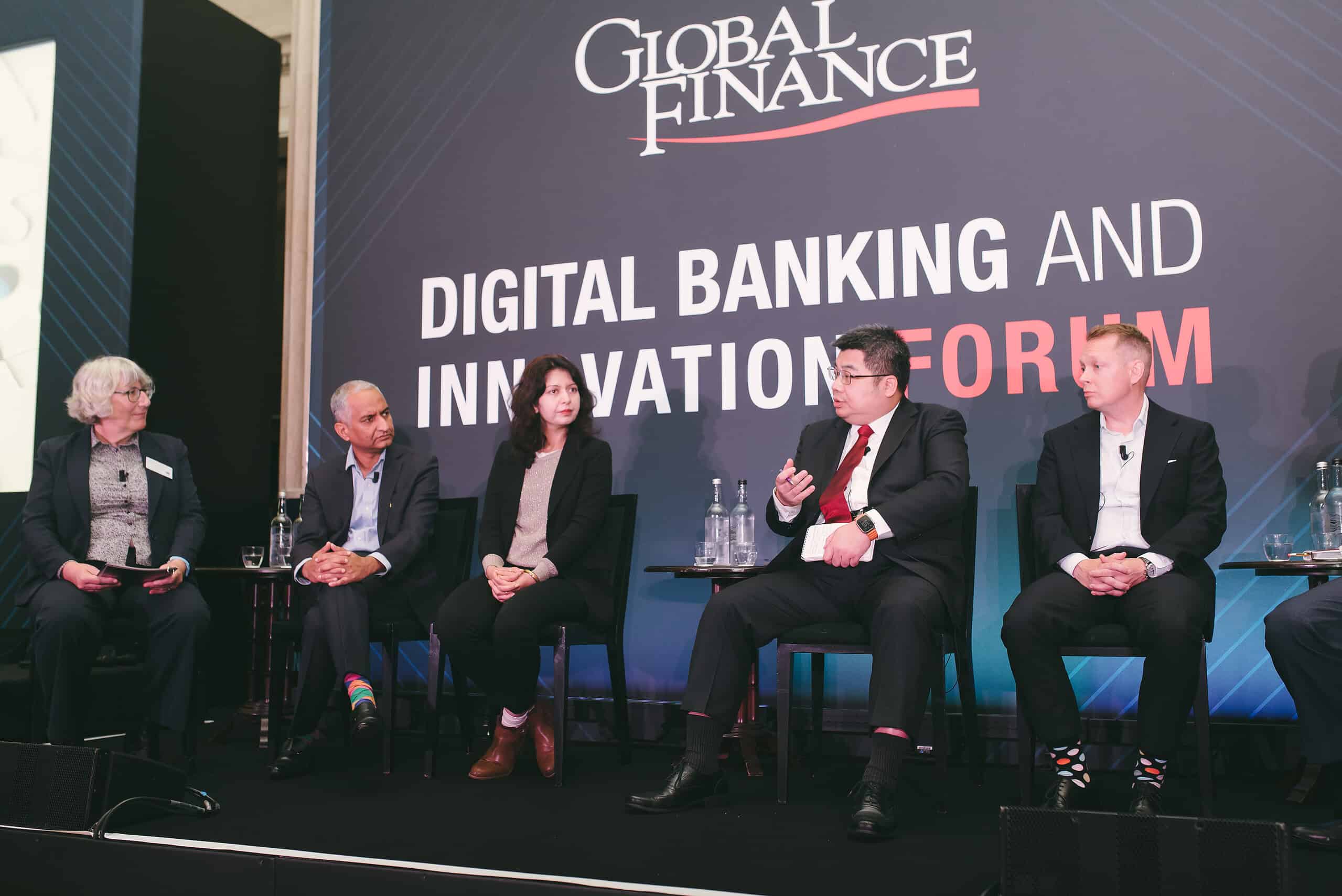- Chinese money fuels hiring spree among private banks in Hong Kong
- Ghana to Seek More IMF Funding, Finance Minister Pick Says
- Should You Use Your Financial Services Firm’s Advisers?
- Dr. Glen Nelson named Vice President for Finance and Planning – News
- New Rules On Federal Inmate Financial Responsibility Program
Artificial Intelligence (AI) has the potential to revolutionize the financial industry, from automating processes to enhancing customer experiences, and financial institutions are approaching this transformation with careful consideration of the ethical implications and potential risks. As AI is piloted and adopted across all aspects of the personal and business banking landscape, Global Finance held a Digital Banking and AI Innovation panel in London with global financial industry leaders to explore the impact of new technologies and how to incorporate them in a way that creates a win-win for all stakeholders.
You are viewing: Making AI Pay Off in Global Banking
Global Finance’s Technology and Transaction Banking Editor Gilly Wright, moderated the distinguished panel, featuring Hussein Al-Abdulla, Head of Alternative Assets and Marketing, Commercial Bank Qatar (CBQ); Sachin Arora, Head of Strategy, Financial Services, Infosys; Olli Anteroinen, Head of SME Digital, Business Banking, Nordea; Payal Jain, Head of Application Engineering and Platforms, Citi; and Friedman Wang, Head of Digital Technology Division, CTBC.
Global Finance: Cutting through the hype, what role can AI play in the way financial services are delivered and consumed?
Sachin Arora: To understand the role and impact of AI, we need to start by looking at how customer experiences are formed.
People don’t wake up in the morning thinking about their bank. Instead, consumers take a more emotional view of money. Also, since bad news travels much faster than good news, one manifestation of good customer experience for banks is really about the downside protection for the brand and what it means to customers.I think of ‘customer experience’ at the intersection of products, processes and people. A firm may have a great product, but the process for how customers interact with the product may be broken. Or, you might have a great process when a customer engages with the call center, but employees may not be well equipped to resolve the customer query.
If we consider AI in this context, one would be able to see the extraordinary potential of AI to enrich a bank’s products, automate its processes and amplify its people in serving the customer.
Sachin Arora is the Associate Vice President and Head of Strategy for Financial Services in Europe, the Middle East, and Africa at Infosys. In addition to his role as AVP, Sachin leads Mergers & Acquisitions for Infosys’ Global Financial Services business. He is a member of the Executive Committee for Global Financial Services, the largest business unit at Infosys, with over $5 billion in annual revenues. Based in London, UK, Sachin has extensive expereince in the banking industry, engaging with regulators and global financial services firms.
Sachin has a proven track record of helping firms with advisory & execution of large-scale transformation and innovation. Operating at the intersection of business and technology, he is passionate about the future of banking in an AI-first era. He is a pragmatist change maker with belief in the power of collaboration with an open ecosystem of clients, partners, startups, and industry bodies.
Global Finance: Cutting through the hype, what role can AI play in the way financial services are delivered and consumed?
Friedman Wang: In Taiwan, we have more than 12 million customers, but only 3% have their own financial advisors. That means the majority do not have access to our wealth management services, which is a flagship business for us and contributes more than 40% of the total bank’s profit. However, from the perspective of our 1,000 financial advisors, even though each of them has around 400 clients, they are only familiar with around one-third of their customers. If we can leverage AI to roll out hyperpersonalization at scale, our wealth management profits would grow significantly.
To date, we have been using an AI algorithm to try to achieve two things: first, to enhance our sales efficiency, by better predicting the next products for our markets; and second, to personalize the service for our customers.
To help us achieve these goals, we are using big data so every advisor can better understand each customer, their life stage and their lifestyle. We can then provide a highly personalized wealth management service.

Friedman Wang, CTBC is responsible for overseeing the development of the bank’s digital technology strategy, implementing innovative business models, delivering digital technology solutions, and managing technology integration and governance.
2018-2023, concurrently the top manager of the Data R&D Center of CTBC Financial Holdings, promoting as director of the Data and Technology R&D Department in 2020. Enabling the creation of a big data R&D center for CTBC Financial Holdings, along with implementing the dual strategic approach of AI. The research and development efforts have garnered numerous global innovation awards from WCIT, Gartner, and IDC.
2005-2019 CTBC Bank – Retail Banking Credit Risk Management Division, Vice President. Deploying personal financial risk management systems and operations internationally, including in China (including Goldmax Consumer Finance Company), The United States, Canada, Japan, the Philippines, Indonesia, and Thailand..
Global Finance: Turning to SME banking, how is AI helping smaller companies?
Olli Anteroinen: I look at the potential for AI for SMEs from a digital service perspective, in terms of not only how we can deliver a good customer experience, but also business outcomes through digital offerings to this segment across the Nordic countries.
Nordea is experimenting with AI to enhance the delivery of digital services to SMEs by improving time to market. We are using the GitHub co-pilot and combining it with our own source code to leverage customer value.
We have also been using virtual assistants since 2017 for both internal staff and our customers. By 2020, we already saw that 80% of our interactions were in chat channels managed by our virtual assistant.

Olli Anteroinen is the Head of SME Digital in Business Banking of Nordea Bank Oyj, the leading financial institution in the Nordics. Olli Anteroinen joined Nordea in 2006 and has worked with Retail (SME) customers and life insurance in various positions, lastly focusing on digital and business development.
He holds a Master of Science degree in Economics and Business Administration (major in Knowledge Management and Information Networks) and Lappeenranta University of Technology, School of Business.
Global Finance: What are the next steps with visualization, another emerging area of AI?
Anteroinen: Our next step will be to enhance the customer experience by leveraging AI in new concepts within digital banking. Data visualization is one of the ways we can leverage AI on different, new concepts within the digital banking services that we provide.
For example, we can use visualization to guide SME customers on cashflow management, combining different datasets that we have within the bank and merging these with customers’ financial data to produce valuable insights for customers. That is on the horizon for us in 2025.
Global Finance: How is AI addressing customer needs and expectations?
Hussein Al-Abdulla: CBQ worked for many years to use AI to develop our systems and processes to improve the customer experience. Some of this has been driven by Qatar’s demographics: over 55% of our country’s population is under the age of 26, so they want to access their banking services via mobile apps rather than branch visits.
We identified the need for this customer experience around eight years ago, and today approximately 95% of our customers use the bank’s mobile app.
COVID-19 accelerated the development of our mobile app, since customers had to use it for their day-to-day activities. For example, CBQ developed an application for domestic maids to open accounts through mobile.
This initiative shows the bank’s focus on meeting our customers’ needs, and I believe we will see increasing development of mobile banking in areas we haven’t explored yet.

Hussein Al-Abdulla, a member of the Executive Management team at Commercial Bank is EGM, Marketing & Alternative Investments. Having started in retail banking at HSBC in Qatar Hussein covers several areas for Commercial Bank and is a specialist in retail banking, marketing, strategic planning, digital transformation and asset management.
Global Finance: Is Generative AI really the answer? AI can be expensive, so how does the cost impact return on investment?
Payal Jain: The good news is AI is increasingly becoming more affordable. Generative AI isn’t always going to be the answer, and we will see other parts of AI make strides in the years to come.
For now, as GenAI has become more accessible and it has reduced the barrier to entry, allowing it to be applied more widely. Initially used to simplify routine tasks, it’s now possible to use it in more complex end-to-end workflows.
At Citi, we consider the ROI of GenAI in terms of the value it brings to us. This is the value of productivity gains across the bank and various stakeholder groups, including engineering, sales, marketing and operations.

Payal Jain is the Head of Application Engineering & Platforms for Citi, she is a part of the CTO Engineering & Architecture. Prior to joining Citi, Payal has been a hands-on engineering leader building planet scale software at Google and Salesforce – she has a passion for building innovative software. Her current focus includes engineering the core GenAI buidling blocks that will enable Citi to make the msot of Generative AI. She is also a Citi Tech Fellow.
Global Finance: As AI is used to innovate more widely, how can we ensure it is also used responsibly? Can you discuss hallucinations in Gen AI?
Arora: : At Infosys, we work with more than 1,000 clients, and some have reported experiencing AI hallucinations. We recommend our clients to not consider hallucinations as a bug; rather think about it as a feature of the large language models. Let me explain.
The quality of output from large language models depends on the databases they are trained on. If the underlying databases have inherent biases to certain dimensions of the business, the model will naturally respond with a certain archetype. The approach to train these models also plays a big role in the degree of accuracy achieved.
We need to ensure consistency, repeatability, predictability, fairness, and avoidance of biases. There are techniques and technologies available to deal with hallucination, so it’s important to switch our mindset and look these as features of the AI process.
Jain: I agree that hallucinations will happen, and they must be expected when building platforms or solutions to run in production in an enterprise. Being rooted in good data is important.
Global Finance: What type of training guardrails does Citi have to deal with fragmented data?
Jain: Data fragmentation is a big issue, and we have been at the forefront when it comes to building guardrails. To incorporate GenAI, we need to take a defensive approach each time we think about deploying a model or releasing a new use case into production. With every application that gets built, we need to make sure the data being used is of a certain classification. We don’t want to expose our most sensitive or restricted data.
We also know that data has been a hard problem to solve for a long time. It’s a priority for us to create better quality data so we can unlock the value in terms of more insights and to access richer metadata that will help us in our AI journey.
Global Finance: What’s the role of the regulators as part of the AI journey, and how are they shaping the way GenAI is being used?
See more : Rachel Reeves says she has ‘iron grip’ on finances as borrowing costs surge | Gilts
Wang: In Taiwan, the regulator issued the first AI governance guidelines in June 2024 that will come into effect by the end of this year.
The regulator asked all the banks to design an AI process that prioritises customers, with a guideline that says banks must offer customers the right to accept a service and to provide an alternative solution.
Banks are looking at it from a risk-based approach, classifying AI applications from low to high risk, and using several factors to define the metrics so we have a clear guide. We are working to define a financial AI standard to create a framework to regulate all players.
Global Finance: : Is collaboration and creating ecosystems the best way to push AI forward?
Al-Abdulla: Yes, collaboration is important because there are a lot of players in the market that bring different capabilities.
One of the things I’m happy about in Qatar is that our regulators, especially the Central Bank, have provided a technology framework that allows banks to collaborate and work with FinTech companies.
For example, we recently worked with one of the investment houses to develop a tool that allows many of our customers to make buy and sell orders through a mobile app.
Global Finance: How do you think about the ‘end game’ when it comes to AI? What are you hoping to achieve?
Anteroinen: Our end game is to make our customers happier and bring leverage to the business in terms of personalization, segmentation, and automation. We want to create clear business value while also ensuring we are responsible and maintain our trust.
Wang: From CTBC’s perspective, we are trying to integrate the two kinds of AI, so that we can offer a relatively safer solution to our customers.
The GenAI and other technologies are advancing faster and faster, and we are trying to roll out virtual banking services by next year to serve as an end game for our bankers to provide affordable services to customers.
Al-Abdulla: I can see social media as a new banking system, for example with WeChat in China, where users can do everything in the app, using a simple platform, once all the requirements are met in terms of privacy and protection. We already see investment houses offering advisory services through social media, which is a comfort zone for a lot of people. I think this is going to happen sooner rather than later.
Global Finance: In what ways can AI potentially be used to reimagine experiences as well as to rearchitect businesses?
Arora: At its very basic, AI & for that matter most new technologies bring forward a set of tools that allow businesses to be more effective and relevant to their customers.
In 2004, when Google first listed as a search engine business it was worth US$27 billion. Not many could have predicted that it would democratize the internet in the way it did and be worth nearly US$2 trillion 20 years later! What does this mean in terms of the potential for Open AI or other such AI trail blazers? Could it become the first US$10 trillion company?
“For me, the real end game is to look at the art of possible and see how we can reimagine the customer experience.”
Sachin Arora, Infosys
But it can’t be done without re-architecting the operating model. AI engineers need to ensure that this tool, which can accelerate business outcomes and customer intimacy, is developed in a safe and compliant way.
At the same time, it requires us all to refresh our mindset as technology shifts and we hit inflection points. Use cases will evolve and applications will evolve, so we all need to ask ourselves – as individuals and professionals – how do we reinvent our roles, as entrepreneurs, employees, and stewards of our organizations?
Global Finance: Thank you all. It’s clear the financial industry is continuing to explore responsibly the possibilities of AI and engaging in thoughtful discussions about its future.
Source link https://gfmag.com/executive-interviews/making-ai-pay-off-in-global-banking/
Source: https://summacumlaude.site
Category: News







